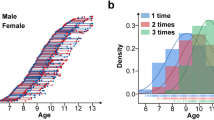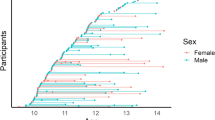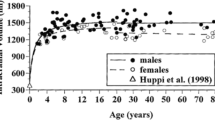Abstract
The maturation of the myelinated white matter throughout childhood is a critical developmental process that underlies emerging connectivity and brain function. In response to genetic influences and neuronal activities, myelination helps establish the mature neural networks that support cognitive and behavioral skills. The emergence and refinement of brain networks, traditionally investigated using functional imaging data, can also be interrogated using longitudinal structural imaging data. However, few studies of structural network development throughout infancy and early childhood have been presented, likely owing to the sparse and irregular nature of most longitudinal neuroimaging data, which complicates dynamic analysis. Here, we overcome this limitation and investigate through concurrent correlation the co-development of white matter myelination and volume, and structural network development of white matter myelination between brain regions as a function of age, using statistically well-supported methods. We show that the concurrent correlation of white matter myelination and volume is overall positive and reaches a peak at 580 days. Brain regions are found to differ in overall magnitudes and patterns of time-varying association throughout early childhood. We introduce time-dynamic developmental networks based on temporal similarity of association patterns in the levels of myelination across brain regions. These networks reflect groups of brain regions that share similar patterns of evolving intra-regional connectivity, as evidenced by levels of myelination, are biologically interpretable and provide novel visualizations of brain development. Comparing the constructed networks between different maternal education groups, we found that children with higher and lower maternal education differ significantly in the overall magnitude of the time-dynamic correlations.









Similar content being viewed by others
References
Bali JL, Boente G, Tyler DE, Wang JL (2011) Robust functional principal components: a projection-pursuit approach. Ann Stat 39(6):2852–2882
Beckmann CF (2012) Modelling with independent components. NeuroImage 62(2):891–901
Bornstein MH, Hahn CS, Suwalsky JTD, Haynes OM (2003) Socioeconomic status, parenting, and child development: the Hollingshead Four-Factor Index of Social Status and the Socioeconomic Index of Occupations. In: Bornstein MH, Bradley RH (eds) Socioeconomic status, parenting, and child development. Lawrence Erlbaum Associates Publishers, Mahwah, pp 29–82
Brett M (1999) The MNI brain and the Talairach atlas, Technical report
Bullmore E, Sporns O (2009) Complex brain networks: graph theoretical analysis of structural and functional systems. Nat Rev Neurosci 10:186–198
Casey BJ, Giedd JN, Thomas KM (2000) Structural and functional brain development and its relation to cognitive development. Biol Psychol 54(1–3):241–257
Castro PE, Lawton WH, Sylvestre EA (1986) Principal modes of variation for processes with continuous sample curves. Technometrics 28(4):329–337
Chevalier N, Kurth S, Doucette MR, Wiseheart M (2015) Myelination is associated with processing speed in early childhood: preliminary insights. PLoS ONE 10(10):e0139897
Croux C, Ruiz-Gazen A (2005) High breakdown estimators for principal components: the projection-pursuit approach revisited. J Multivar Anal 95(1):206–226
Dai X, Hadjipantelis PZ, Han K, Ji H, Lin SC, Müller HG, Wang JL (2018) fdapace: functional data analysis and empirical dynamics. R package version 0.4.0. https://cran.r-project.org/package=fdapace. Accessed 30 Oct 2018
Dean DC III, Dirks H, O’Muircheartaigh J, Walker L, Jerskey BA, Lehman K et al (2014a) Pediatric neuroimaging using magnetic resonance imaging during non-sedated sleep. Pediatr Radiol 44(1):64–72
Dean DC III, O’Muircheartaigh J, Dirks H, Waskiewicz N, Lehman K, Walker L et al (2014b) Modeling healthy male white matter and myelin development: 3 through 60 months of age. NeuroImage 84:742–752
Dean DC, O’Muircheartaigh J, Dirks H, Waskiewicz N, Walker L, Doernberg E, Piryatinsky I, Deoni SC (2015) Characterizing longitudinal white matter development during early childhood. Brain Struct Funct 220(4):1921–1933
Dementieva YA, Vance DD, Donnelly SL, Elston LA, Wolpert CM, Ravan SA, DeLong GR, Abramson RK, Wright HH, Cuccaro ML (2005) Accelerated head growth in early development of individuals with autism. Pediatr Neurol 32(2):102–108
Deoni SCL (2011) Correction of main and transmit magnetic field (B0 and B1) inhomogeneity effects in multicomponent-driven equilibrium single-pulse observation of T1 and T2. Magn Reson Med 65(4):1021–1035
Deoni SCL, Dean DC III, O’Muircheartaigh J, Dirks H, Jerskey BA (2012) Investigating white matter development in infancy and early childhood using myelin water faction and relaxation time mapping. NeuroImage 63(3):1038–1053
Deoni SC, Dean DC III, Piryatinsky I, O’Muircheartaigh J, Waskiewicz N, Lehman K, Han M, Dirks H (2013a) Breastfeeding and early white matter development: a cross-sectional study. NeuroImage 82:77–86
Deoni SCL, Matthews L, Kolind SH (2013b) One component? Two components? Three? The effect of including a nonexchanging “free” water component in multicomponent driven equilibrium single pulse observation of T1 and T2. Magn Reson Med 70(1):147–154 (PMCID: 3711852)
Deoni SCL, Rutt BK, Arun T (2008) Gleaning multicomponent T1 and T2 information from steady-state imaging data. Magn Reson Med 60(6):1372–1387
Deoni SCL, O’Muircheartaigh J, Elison JT, Walker L, Doernberg E, Waskiewicz N, Dirks H, Piryatinsky I, Dean DC III, Jumbe NL (2016) White matter maturation profiles through early childhood predict general cognitive ability. Brain Struct Funct 221(2):1189–1203
Durston S, Casey BJ (2006) What have we learned about cognitive development from neuroimaging? Neuropsychologia 44(11):2149–2157
Fair DA, Dosenbach NUF, Church JA, Cohen AL, Brahmbhatt S, Miezin FM et al (2007) Development of distinct control networks through segregation and integration. PNAS 104(33):13507–13512 (PMCID: PMC1940033)
Fair DA, Nigg JT, Iyer S, Bathula D, Mills KL, Dosenbach NUF et al (2012) Distinct neural signatures detected for ADHD subtypes after controlling for micro-movements in resting state functional connectivity MRI data. Front Syst Neurosci 6:80 (PMCID: PMC3563110)
Fan J, Gijbels I (1996) Local polynomial modelling and its applications: monographs on statistics and applied probability, vol 66. CRC Press, Boca Raton
Fan J, Yao Q (1998) Efficient estimation of conditional variance functions in stochastic regression. Biometrika 1:645–660
Fornito A, Zalesky A, Pantelis C, Bullmore ET (2012) Schizophrenia, neuroimaging and connectomics. NeuroImage 62(4):2296–2314
Gao W, Alcauter S, Elton A, Hernandez-Castillo CR, Smith JK, Ramirez J et al (2015) Functional network development during the first year: relative sequence and socioeconomic correlations. Cereb Cortex 25(9):2919–2928 (PMCID: PMC4537436)
Grenander U (1950) Stochastic processes and statistical inference. Arkiv för matematik 1(3):195–277
Hackman DA, Farah MJ (2009) Socioeconomic status and the developing brain. Trends Cogn Sci 13(2):65–73 (PMCID: PMC3575682)
Hair NL, Hanson JL, Wolfe BL, Pollak SD (2015) Association of child poverty, brain development, and academic achievement. JAMA Pediatr 169(9):822–829 (PMCID: PMC4687959)
Hensch TK, Bilimoria PM (2012) Re-opening windows: manipulating critical periods for brain development. Cerebrum 2012:11 (PMCID: PMC3574806)
Hoeffding W (1940) Masstabinvariante korrelationstheorie, vol 5. Schriften Des Mathematischen Instituts Und Des Instituts Für Angewandte Mathematik Der Universität Berlin, Berlin, pp 181–233
Hollingshead AB (1975) Four factor index of social status, Technical report
Jenkinson M, Bannister P, Brady M, Smith S (2002) Improved optimization for the robust and accurate linear registration and motion correction of brain images. NeuroImage 17(2):825–841
Johnson MH (2001) Functional brain development in humans. Nat Rev Neurosci 2:475–483
Jones MC, Rice JA (1992) Displaying the important features of large collections of similar curves. Am Stat 46(2):140–145
Kolind SH, Matthews L, Johansen-Berg H, Leite MI, Williams SCR, Deoni S, Palace J (2012) Myelin water imaging reflects clinical variability in multiple sclerosis. NeuroImage 60:263–270
Lewis JD, Theilmann RJ, Townsend J, Evans AC (2013) Network efficiency in autism spectrum disorder and its relation to brain overgrowth. Front Hum Neurosci 7:845
MacKay AL, Vavasour IM, Rouscher A, Kolind SH, Madler B, Moore GR, Traboulsee AL, Li DK, Laule C (2009) MR relaxation in multiple sclerosis. Neuroimaging Clin 19:1–26
Marín O (2016) Developmental timing and critical windows for the treatment of psychiatric disorders. Nat Med 22(11):1229–1238
Mori S, Oishi K, Jiang H, Jiang L, Li X, Akhter K et al (2008) Stereotaxic white matter atlas based on diffusion tensor imaging in an ICBM template. NeuroImage 40:570–582
Mullen EM (1995) Mullen scales of early learning, Technical report
Müller HG (1987) Weighted local regression and kernel methods for nonparametric curve fitting. J Am Stat Assoc 82(397):231–238
Müller HG (2005) Functional modelling and classification of longitudinal data. Scand J Stat 32(2):223–240
Nagy Z, Westerberg H, Klingberg T (2004) Maturation of white matter is associated with the development of cognitive functions during childhood. J Cogn Neurosci 16(7):1227–1233 (PMCID: 15453975)
Noble KG, Norman MF, Farah MJ (2005) Neurocognitive correlates of socioeconomic status in kindergarten children. Dev Sci 8:74–87
Noble KG, Houston SM, Brito NH, Bartsch H, Kan E, Kuperman JM et al (2015) Family income, parental education and brain structure in children and adolescents. Nat Neurosci 18(5):773–778 (PMCID: PMC4414816)
O’Brien JS, Sampson EL (1965) Lipid composition of the normal human brain: gray matter, white matter, and myelin. J Lipid Res 6(4):537–544
O’Muircheartaigh J, Dean DC, Ginestet CE, Walker L, Waskiewicz N, Lehman K, Dirks H, Piryatinsky I, Deoni SC (2014) White matter development and early cognition in babies and toddlers. Hum Brain Mapp 35(9):4475–4487
Paus T (2010) Growth of white matter in the adolescent brain: Myelin or axon? Brain Cogn 72(1):26–35
Petersen A, Deoni S, Müller HG (2018) Fréchet estimation of time-varying covariance matrices from sparse data, with application to the regional co-evolution of myelination in the developing brain. Ann Appl Stat (to appear). https://www.imstat.org/journals-and-publications/annals-of-applied-statistics/annals-of-applied-statisticsnext-issues/
Ramsay JO, Silverman BW (2005) Functional data analysis, 2nd edn. Springer, Berlin
Raschle N, Zuk J, Ortiz-Mantilla S, Sliva DD, Franceschi A, Grant PE, Benasich AA, Gaab N (2012) Pediatric neuroimaging in early childhood and infancy: challenges and practical guidelines. Ann N Y Acad Sci 1252(1):43–50
Shaw P, Greenstein D, Lerch J, Clasen L, Lenroot R, Gogtay N et al (2006) Intellectual ability and cortical development in children and adolescents. Nature 440(7084):676–679 (PMCID: 16572172)
Shaw P, Lalonde F, Lepage C, Rabin C, Eckstrand K, Sharp W et al (2009) Development of cortical asymmetry in typically developing children and its disruption in attention-deficit/hyperactivity disorder. Arch Gen Psychiatry 66(8):888–896. PMCID: PMC2948210
Silverman BW (1986) Density estimation for statistics and data analysis. Chapman & Hall, London
Sirin SR (2005) Socioeconomic status and academic achievement: a meta-analytic review of research. Rev Educ Res 75:417–453
Smith SM (2002) Fast robust automated brain extraction. Hum Brain Mapp 17(3):143–155
Smith SM, Vidaurre D, Beckmann CF, Glasser MF, Jenkinson M, Miller KL et al (2013) Functional connectomics from resting-state fMRI. Trends Cogn Sci 17(12):666–682 (PMCID: PMC4004765)
Supekar K, Uddin LQ, Prater K, Amin H, Greicius MD (2010) Development of functional and structural connectivity within the default mode network in young children. NeuroImage 52:290–301
Uddin LQ, Supekar K, Menon V (2010) Typical and atypical development of functional human brain networks: insights from resting-state FMRI. Front Syst Neurosci 4:21 (PMCID: PMC2889680)
van der Knaap MS, Valk J, Bakker CJ, Schooneveld M, Faber JA, Willemse J et al (1991) Myelination as an expression of the functional maturity of the brain. Dev Med Child Neurol 33(10):849–857 (PMCID: 1743407)
Vogel AC, Power JD, Petersen SE, Schlaggar BL (2010) Development of the brain’s functional network architecture. Neuropsychol Rev 20:362–375
Wang J, Zuo X, He Y (2010) Graph-based network analysis of resting-state functional MRI. Front Syst Neurosci 4:16
Wang JL, Chiou JM, Müller HG (2016) Review of functional data analysis. Annu Rev Stat Appl 3:257–295
Wolff JJ, Gu H, Gerig G, Elison JT, Styner M, Gouttard S et al (2012) Differences in white matter fiber tract development present from 6 to 24 months in infants with autism. Am J Psychiatry 169(6):589–600 (PMCID: 3377782)
Wood TC, Simmons C, Hurley SA, Wernon AC, Torres J, Dell’Acqua F, Williams SCR, Cash D (2016) Whole brain ex-vivo quantitative MRI of the cuprizone mouse model. PeerJ 4:e2632
Yakovlev PI, Lecours AR (1967) The myelogenetic cycles of regional maturation of the brain. In: Minkowski A (ed) Regional development of the brain in early life. Blackwell, Oxford, pp 3–70
Zatorre RJ, Fields RD, Johansen-Berg H (2012) Plasticity in gray and white: neuroimaging changes in brain structure during learning. Nat Neurosci Nat Publ Group 15(4):528–536 (PMCID: PMC3660656)
Zhang X, Wang JL (2016) From sparse to dense functional data and beyond. Ann Stat 44(5):2281–2321
Zhang Y, Brady M, Smith S (2001) Segmentation of brain MR images through a hidden Markov random field model and the expectation-maximization algorithm. IEEE Trans Med Imaging 20(1):45–57
Zhang H, Meltzer P, Davis S (2013) RCircos: an R package for Circos 2D track plots. BMC Bioinform 14(1):244
Zhou Y, Lin SC, Wang JL (2018) Local and global temporal correlations for longitudinal data. J Multivar Anal 167(2018):1–14
Acknowledgements
This work was supported by the National Science Foundation (DMS-1407852, DMS-1512975), the National Institutes of Mental Health (R01 MH087510), and the Bill and Melinda Gates Foundation (OPP11002016).
Author information
Authors and Affiliations
Corresponding author
Electronic supplementary material
Below is the link to the electronic supplementary material.
Appendix
Appendix
Estimation of correlation functions
The functional correlation \({\text{corr}}(X(t),Y(t))\) is estimated by the plug-in estimator
We propose to estimate \({\text{cov}}(X(t),Y(t))\), \({\text{var}}(X(t))\), and \({\text{var}}(Y(t))\) separately by kernel local linear smoothing the pooled centered observations, which is detailed as follows. Assume we make observations \(({t_{ij}},{X_{ij}},{Y_{ij}})\) at each time \({t_{ij}}\), for subject \(i=1, \ldots ,n\) and visit \(j=1, \ldots ,{n_i}\), where \({X_{ij}}=X({t_{ij}})\), \({Y_{ij}}=Y({t_{ij}})\), \(n\) is the number of subjects and \({n_i}\) is the number of measurements per subject.
We first estimate \({\mu _X}(t):=E(X(t))\) and \({\mu _Y}(t):=E(Y(t))\) by kernel local linear smoothing. We define the local linear kernel smoother for \({\mu _X}(t)\) as \({\hat {\mu }_X}(t)={\hat {\beta }_0}\) by smoothing the pooled observation \(\{ ({t_{ij}},{X_{ij}})\} _{{i=1}}^{n}{_{{j=1}}^{{{n_i}}}}\), where
\(h>0\) is the bandwidth, and \(K( \cdot )\) is a kernel function. The mean function \({\mu _Y}(t)\) of \(Y(t)\) can be estimated similarly by smoothing \(\{ ({t_{ij}},{Y_{ij}})\} _{{i=1}}^{n}{_{{j=1}}^{{{n_i}}}}\). Next we obtain the centered observations
for \(i=1, \ldots ,n\) and \(j=1, \ldots ,{n_i}\). Finally, \(\widehat {{\operatorname{cov} }}(X(t),Y(t))\) (resp. \(\widehat {{\operatorname{var} }}(X(t))\) and \(\widehat {{\operatorname{var} }}(Y(t))\)) is obtained by smoothing \(\{ ({t_{ij}},{\tilde {X}_{ij}}{\tilde {Y}_{ij}})\} _{{i=1}}^{n}{_{{j=1}}^{{{n_i}}}}\) (resp. \(\{ ({t_{ij}},{\tilde {X}_{ij}}^{2})\} _{{i=1}}^{n}{_{{j=1}}^{{{n_i}}}}\) and \(\{ ({t_{ij}},{\tilde {Y}_{ij}}^{2})\} _{{i=1}}^{n}{_{{j=1}}^{{{n_i}}}}\)) as in (5). For all kernel local smoothing we used Gaussian kernel for \(K( \cdot )\) with bandwidth \(h\) equal to 150 days.
Note that one can write \(\operatorname{var} (X(t))=E({X^2}(t)) - {\mu _X}{(t)^2}\) and thus construct another plug-in estimate \(\widehat {{\operatorname{var} }}(Y(t))\) from \(\hat {E}(X{(t)^2}) - {\hat {\mu }_X}{(t)^2}\) by smoothing \(\{ ({t_{ij}},X_{{ij}}^{2})\} _{{i=1}}^{n}{_{{j=1}}^{{{n_i}}}}\) for \(\hat {E}(X{(t)^2})\) and \(\{ {t_{ij}},{X_{ij}}\} _{{i=1}}^{n}{_{{j=1}}^{{{n_i}}}}\) for \({\hat {\mu }_X}(t)\). This alternative procedure is known to have larger bias than the proposed procedure (see for example Fan and Yao 1998; Zhang and Wang 2016) and thus is not used here. An alternative approach is Frechet regression (Petersen et al. 2018).
Modes of variation
The modes of variation for functional data was discussed by Castro et al. (1986) and Jones and Rice (1992). Given a random function \(X(t)\), we target to summarize its important variability using a few basis functions. Denoting \({X^C}(t)=X(t) - \mu (t)\) as the centered process, our goal is to approximate \({X^C}(t)\) by \(X_{J}^{C}(t)=\sum\nolimits_{{j=1}}^{J} {{\xi _j}{\psi _j}(t)}\) using a few basis functions, where \(\{ {\psi _j}(t)\} _{{j=1}}^{J}\) is an orthonormal basis of \({L^2}\)and the \({\xi _j}\) are the \(j\)th Fourier coefficients of \({X^C}\) projected onto \({\psi _j}\). Using a suitably defined notion of total variation for functional data, the best J-dimensional approximation \(X_{J}^{C}(t)\) to \({X^C}(t)\) in terms of total variation explained is given by the orthonormal basis that solves
An explicit solution to (6) is given by the eigenfunctions of \(G(s,t)=\,{\text{cov}}(X(s),X(t))\). Covariance function \(G\) has spectral decomposition
where the \({\lambda _1} \geq {\lambda _2} \geq \cdots \geq 0\) are the eigenvalues and the \({\phi _{\text{j}}}({\text{t}})\) are the corresponding orthonormal eigenfunction. It is then well-known the first \(J\) eigenfunctions \({\phi _1}, \ldots ,{\phi _J}\) of the covariance operator \(G\) is a solution to (6), corresponding to the principal modes of variation, and the eigenvalue \({\lambda _j}\) associated with \({\phi _j}\) quantifies how much variation is explained by the \(j\)th eigenfunction. The fraction of total variation explained by the \(j\)th eigenfunction is \({\lambda _j}/\sum\nolimits_{{j=1}}^{\infty } {{\lambda _j}}\).
Rights and permissions
About this article
Cite this article
Dai, X., Müller, HG., Wang, JL. et al. Age-dynamic networks and functional correlation for early white matter myelination. Brain Struct Funct 224, 535–551 (2019). https://doi.org/10.1007/s00429-018-1785-z
Received:
Accepted:
Published:
Issue Date:
DOI: https://doi.org/10.1007/s00429-018-1785-z




